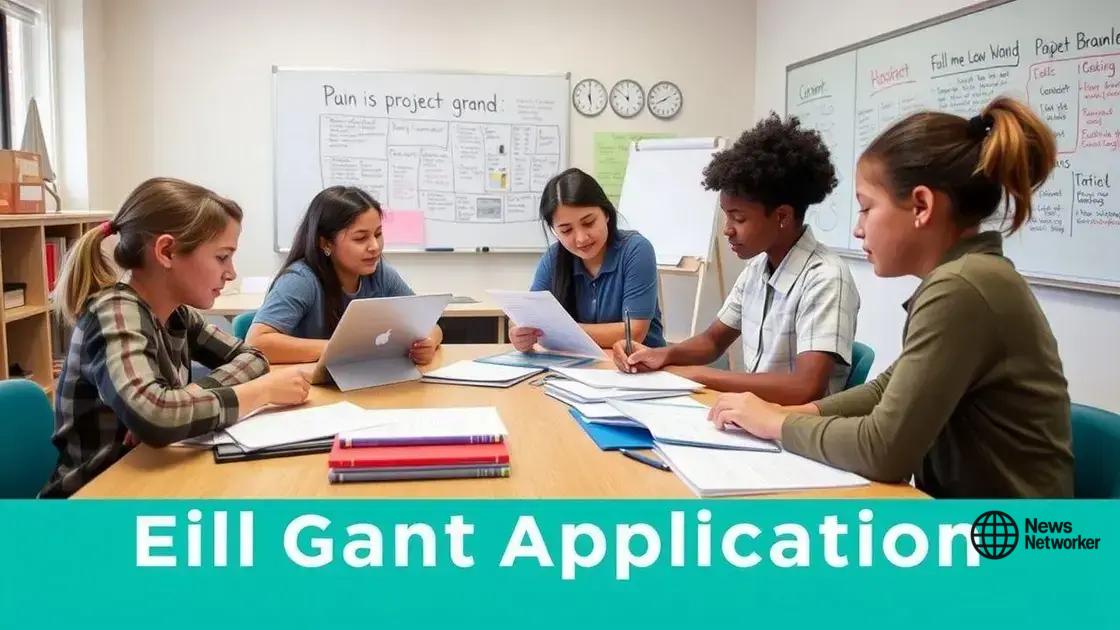School building climate grants: How they can benefit your community

School building climate grants provide essential funding for educational institutions to improve sustainability through projects like renewable energy installations and energy-efficient upgrades, benefiting both students and local communities.
School building climate grants are designed to enhance the sustainability and resilience of educational facilities. Have you ever wondered how these grants can transform schools into healthier environments for students? Let’s explore their significance.
Understanding school building climate grants
Understanding school building climate grants is essential for schools looking to enhance their facilities and promote sustainability. These grants offer funding that can help schools improve their environments, making them healthier and more energy-efficient for students.
There are several components to consider regarding these grants, including their purpose and application process. Schools can access funding to support various projects that focus on environmental sustainability. Examples of such projects range from installing solar panels to upgrading heating and cooling systems for better energy efficiency.
Types of projects funded by climate grants
Now, let’s look at the types of projects typically funded through these climate grants. Schools often focus on initiatives that lead to long-term benefits.
- Upgrading insulation and windows for energy efficiency.
- Implementing renewable energy solutions like solar or wind power.
- Installing energy-efficient lighting and appliances.
- Creating green spaces and gardens that enhance learning environments.
These projects are beneficial not only for schools but also for the broader community. They reduce energy costs and create a healthier atmosphere for students to learn and grow.
Moreover, understanding the eligibility requirements for these grants is crucial. Schools must demonstrate their commitment to sustainability and innovative practices to qualify. This typically involves showing previous efforts that align with the goals of the grant program.
By exploring the application process, schools can better position themselves to secure funding. Gathering the necessary documentation and clearly outlining the proposed project are key steps for any school aiming to apply. Additionally, collaborating with local environmental organizations can strengthen the application by showcasing community support.
Overall, engaging with school building climate grants presents a remarkable opportunity for districts to transform their facilities while promoting sustainability. This way, schools contribute positively to their environments, directly benefiting their students and the community at large.
Eligibility criteria for grants
Eligibility criteria for school building climate grants help determine which schools can apply for funding. These criteria are key to ensuring that the grants reach schools that truly need support.
Typically, schools must meet several important qualifications. One major requirement is the school’s commitment to sustainability practices. This means that schools should already be taking steps to reduce their environmental impact, like implementing recycling programs or energy-saving measures.
Common eligibility requirements
Schools interested in applying for climate grants should be aware of the following common criteria.
- Must be a public or nonprofit school serving students.
- Should demonstrate a clear plan for the intended project.
- Must provide evidence of community support or collaboration.
- Should have a history of environmental initiatives.
In addition to these points, funding amounts may depend on the size of the school and the scope of the proposed project. Schools with larger projects may need to show how they will manage and utilize the funds effectively. It’s important for applicants to prepare detailed proposals that outline their objectives, timelines, and anticipated outcomes.
Successfully meeting eligibility criteria can open up numerous opportunities for schools. It not only allows them to access funding but also positions them as leaders in environmental sustainability within their communities. This can inspire other schools to follow suit and contribute to broader environmental efforts.
Understanding these eligibility requirements is a crucial step for schools wishing to benefit from climate grants. By aligning their initiatives with the funding goals, schools can enhance their learning environments while positively impacting the planet.
How to apply for climate grants

Applying for climate grants can seem challenging, but understanding the process makes it much easier. Schools should start by gathering essential information and resources before diving into the application.
The first step is to identify the specific grant programs available. Many organizations offer these grants, each with its own requirements. Schools can often find lists of available grants on government or nonprofit websites dedicated to education and environmental sustainability.
Essential steps in the application process
Once the appropriate grant has been identified, schools should follow a series of essential steps.
- Review the guidelines and eligibility criteria carefully.
- Gather necessary documentation, including budgets and project plans.
- Develop a detailed proposal that outlines project goals and anticipated impacts.
- Seek feedback from peers or local community leaders.
Writing a compelling proposal is critical. Schools should clearly articulate how the funding will be used and the benefits it will bring to students and the community. Understanding the specific goals of the grant can help tailor the application effectively. For instance, if the grant focuses on energy efficiency, schools should highlight how their projects contribute to reducing energy consumption.
Collaboration can significantly enhance an application. Schools might consider partnering with local businesses or environmental organizations. Not only can this strengthen the proposal, but it also showcases community engagement, which grants often favor.
Finally, submitting the application on time is crucial. Missing deadlines can disqualify a school from funding opportunities. Therefore, it’s helpful to create a timeline to manage all aspects of the application process and ensure everything is submitted promptly.
Successful projects funded by climate grants
Successful projects funded by climate grants showcase how schools can significantly impact their environments and communities. These initiatives often highlight innovative solutions for sustainability that inspire others.
Many schools have used climate grants to undertake projects with impressive outcomes. For example, some have transformed their campuses by incorporating renewable energy sources. Solar panels are now a common feature, allowing schools to generate their own electricity and save on energy costs. This not only benefits the school’s budget but also serves as a teaching tool for students about renewable energy.
Examples of impactful projects
Several notable projects funded by climate grants include:
- Installation of energy-efficient HVAC systems in classrooms, reducing energy consumption significantly.
- Creation of green gardens that promote biodiversity and offer hands-on learning experiences for students.
- Upgrading school facilities to include better insulation and windows, improving energy efficiency.
- Community education programs that teach sustainability practices to students and their families.
These projects are not just about saving money; they are also about creating healthier learning environments. Many schools report improved air quality and better student health as a result of these initiatives. Additionally, involving students in the planning and implementation phases encourages engagement and instills a sense of ownership over their school environment.
Partnerships with local businesses and environmental organizations further enhance the impact of these projects. Collaboration can lead to additional funding and resources, allowing schools to take on even larger initiatives. This type of teamwork fosters community involvement and support.
By looking at these successful examples, other schools can find inspiration and ideas for their own projects. The potential of climate grants to fund transformative initiatives means schools can lead the way in making a difference for future generations.
The impact of climate grants on local communities
The impact of climate grants on local communities is profound and multifaceted. These grants not only enhance school facilities but also foster a sense of community engagement and environmental awareness.
When schools receive funding from climate grants, they often embark on projects that benefit not just students, but everyone in the vicinity. For instance, the installation of solar panels or the development of green spaces creates a positive ripple effect that reaches local residents. These initiatives promote clean energy use and expand access to green areas for recreation and learning.
Benefits to local communities
Here are some significant benefits that local communities gain from school projects funded by climate grants:
- Improved environmental quality: Projects that enhance sustainability reduce pollution and improve air and water quality.
- Community education: Schools often host workshops and programs that educate families and local residents about sustainable practices.
- Economic benefits: Eco-friendly projects can lead to job creation and stimulate local economies through partnerships with businesses.
- Enhanced community pride: Seeing schools take action for the environment fosters a sense of pride and responsibility among residents.
In many cases, increased collaboration occurs between schools and community organizations. These partnerships can lead to more significant community projects, such as tree planting events or clean-up initiatives. Schools become hubs of activity, encouraging participation and fostering a community spirit.
Additionally, the visibility of these projects can inspire other institutions. When local schools lead by example, they motivate neighboring schools and organizations to implement their own sustainability initiatives. This collaboration multiplies the positive impact on the environment and enhances community involvement.
Overall, the influence of climate grants extends far beyond school walls. By improving school facilities and promoting sustainable practices, communities become more connected, educated, and resilient.
climate grants play a critical role in transforming schools and benefiting local communities. These grants enable schools to implement sustainable projects that improve the learning environment while promoting environmental stewardship. Through initiatives funded by these grants, schools can lead the way in fostering community engagement and awareness. The positive impacts extend beyond just the students, reaching families and community members alike, inspiring everyone to contribute to a healthier future. By understanding and utilizing climate grants effectively, schools can make a lasting difference that resonates throughout their communities.
FAQ – Frequently Asked Questions about Climate Grants for Schools
What are climate grants for schools?
Climate grants for schools are funding opportunities aimed at improving sustainability and environmental practices within educational institutions.
How can climate grants benefit my school?
These grants help schools implement eco-friendly projects, reduce energy costs, enhance learning environments, and engage the community in sustainability efforts.
What types of projects are typically funded by climate grants?
Common projects include solar panel installations, energy-efficient upgrades, green space development, and community education programs on environmental issues.
How do I apply for a climate grant?
To apply for a climate grant, identify eligible grant programs, gather necessary documentation, and submit a well-prepared proposal outlining the planned project.





